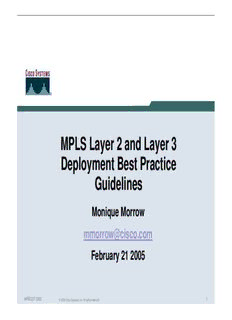
MPLS Layer 2 and Layer 3 Deployment Best Practice - apricot PDF
Preview MPLS Layer 2 and Layer 3 Deployment Best Practice - apricot
MPLS Layer 2 and Layer 3 Deployment Best Practice Guidelines Monique Morrow [email protected] February 21 2005 APRICOT 2005 ©2003 Cisco Systems, Inc. All rights reserved. 1 Prerequisites and Scope • Must understand fundamental MPLS principles • Must understand basic routing especially BGP APRICOT 2005 ©2003 Cisco Systems, Inc. All rights reserved. 222 Agenda • Dynamics and Background • Layer 3 : Half-Duplex VRF • Inter-Provider Considerations • Layer 2 Deployment Considerations • A Word on VPLS • A Word on Traffic Engineering • Management Considerations and MPLS OAM • Security Considerations • What About G-MPLS? • Summary APRICOT 2005 ©2003 Cisco Systems, Inc. All rights reserved. 333 Service Provider Network Operation OSS OSS FR, ATM TDM TDM TDM IP OSS MPLS OSS FR, ATM OSS FR, ATM IP OSS • Create operational efficiencies and increase automation in a highly technology-intensive market • Enable competitive differentiation and customer retention through high- margin, bundled services • Progressively consolidate disparate networks • Sustain existing business while rolling out new services APRICOT 2005 ©2003 Cisco Systems, Inc. All rights reserved. 444 MPLS’s Momentum in Convergence & Service Creation • IDC, July 2004: • Heavy Reading Jan. 2004: Increasingly, service providers use MPLS as the Most of the world’s telecom service providers now cornerstone for traffic routing capabilities for converged agree in principle that they must migrate to frame, ATM, and packet based networks to improve QoS converged backbones, and that MPLS (Multiprotocol visibility and assure service level guarantees. Label Switching) technology will enable this migration. • CIBC World Markets, June 2004: • Heavy Reading Sep. 2003: The most significant trend was a wholesale shift to IP- MPLS as the new foundation technology for carriers’ MPLS is gaining support from MSPP vendors as a data networks. This transition appears irreversible and key mechanism for enabling packet services, QoS, is gaining momentum surprisingly fast. and traffic engineering in the metro. • Even in Dilbert Comic Strip, May 2004: APRICOT 2005 ©2003 Cisco Systems, Inc. All rights reserved. 555 MPLS Services and Transport Network Management L3VPN Programmable MSE Low End Edge Interface L3VPN Evolution from today Scale instrumentation Managing CPE ATM/FR legacy feature parity Provisioning Multicast VPN Performance OAM & Troubleshooting Connection Traffic Management Traffic Eng Engineering L2/L3 + Optical AToM Interworking MAC address L2TPv3 VLAN L2 Switch Management Management Management L2VPN Metro E Layer 2/3 Management Essentials: IP/MPLS Routing, QoS, TE, OAM, HA APRICOT 2005 ©2003 Cisco Systems, Inc. All rights reserved. 666 Agenda • Dynamics and Background • Layer 3 : Half-Duplex VRF • Inter-Provider Considerations • Layer 2 Deployment Considerations • A Word on VPLS • A Word on Traffic Engineering • Management Considerations and MPLS OAM • Security Considerations • What About G-MPLS? • Summary APRICOT 2005 ©2003 Cisco Systems, Inc. All rights reserved. 777 Why Half Duplex VRFs? Problem • Only way to implement hub and spoke topology is to put every spoke into a single and unique VRF Ensures that spokes do not communicate directly • Single VRF model, which does not include HDV, impairs the ability to bind traffic on the upstream ISP Hub APRICOT 2005 ©2003 Cisco Systems, Inc. All rights reserved. 888 Why Half Duplex VRFs? Solution • HDV allows the wholesale Service Provider to provide true hub and spoke connectivity to subscribers, who can be connected to the: Same or different PE-router(s) Same or different VRFs, via the upstream ISP APRICOT 2005 ©2003 Cisco Systems, Inc. All rights reserved. 999 Technical Justification • Problem PE requires multiple VRF tables for multiple VRFs to push spoke traffic via hub If the spokes are in the same VRF (no HDV), traffic will be switched locally and will not go via the hub site • Solution HDVs allows all the spoke site routes in one VRF • Benefit Scalability for Remote Access to MPLS connections Reduces memory requirements by using just two VRF tables Simplifies provisioning, management, and troubleshooting by reducing the number of Route Target and Route Distinguisher configuration APRICOT 2005 ©2003 Cisco Systems, Inc. All rights reserved. 111000
Description: